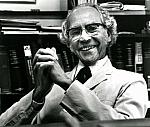On February 26, 1954, Michigan Rep Ruth Thompson (R) introduces legislation to ban mailing “obscene, lewd, lascivious or filthy” phonograph (rock & roll) records.
Much more noteworthy, Thompson was elected as a Republican from Michigan’s 9th congressional district to the 82nd Congress in 1950 and subsequently re-elected to the two succeeding Congresses serving from January 3, 1951 to January 3, 1957 in the U.S. House. She was the first woman to represent Michigan in Congress and the first woman to serve on the House Judiciary Committee.
Source : HistoryOrb.com and wikipedia

On February 26, 1957, Michigan Governor G. Mennen Williams signed a bill changing the name of Western Michigan College to Western Michigan University, making WMU the state’s 4th university.
Note : Campus and community members fill the Sangren Pedestrian Mall each fall for the Bronco Bash welcome-to-Western party.
Source :
James Minder resigned as CEO of Smith & Wesson at age 74, the country’s second-biggest handgun maker, when it was revealed he worked his way through the University of Michigan as a stick-up man. Minder spent 15 years in Michigan prisons for armed robberies and an attempted prison escape.
But wait, there’s even more to the story.
See Kim Clarke and James Tobin, “The Robber’s Third Chance“, University of Michigan Heritage Project.
Sources :
Historical Society of Michigan
“Smith & Wesson chief quits over crime; Chairman of the nation’s No. 2 gun maker resigns over past armed robbery; company names new chief”, CNN Money, February 27, 2004.
Savvy families have a new must-see list with the reveal of our readers’ winners for Best Museum for Families. Each of our winners makes an excellent destination on wet or chilly days, or a fun weekend outing in any weather. Many of the winning museums also have exhibits and activities which will keep teens and adults entertained.
Needless to say, the Henry Ford Museum was the only Michigan museum in the top ten.
Source:
USA Today’s 10 best museums for families, February 26, 2014.
As about 600 people assembled to hear a speech by the Rev. Al Sharpton at Michigan State University´s Wharton Center Feb. 26, several attendees noted, with a touch of regret, that they were missing the MSU- Minnesota basketball game. Sharpton gave them reason to be happy with their choice, and not just because the Spartans lost that night. No Big 10 squad mixes defense with offense as deftly as Sharpton does all by himself.
The only way to honor the civil rights landmarks of previous generations, he said, is to “complete the journey.”
“The fight today is on criminal justice, preserving voting and democratizing health care,” he said. “The challenge is not just to recount and celebrate black history but to continue to make it.”
Lawrence Cosentino, “Offense and defense; Sharpton challenges Wharton Center crowd to make more black history”, Lansing City Pulse, March 4, 2015.
Orphaned as a young boy, Russell Alger went on to study law and began a practice in Cleveland. During the Civil War, Alger became colonel of the Fifth and Sixth Michigan Regiments. After the war, he moved to Michigan and founded the Manistee Lumber Company, becoming one of the state’s wealthiest men. In 1884, he won election as Michigan governor, and in 1892, he was appointed Secretary of War during the Spanish-American War by President McKinley. From 1902-1907 he served Michigan as a United States Senator.
Source : Michigan Historical Calendar, courtesy of the Clarke Historical Library at Central Michigan University.
For more on Russell Alger, see “April 2, 1861 : Russell A. Alger, Sr. Marries Annette Huldana Squire
The March 7, 1899 issue of the MAC Record, an alumni publication, reveals that the M.A.C. Aggies played their first basketball game against Olivet, loosing 6-7. The teams were so evenly matched that at the end of two 20-minute periods they were tied. In the eight minute mark of the third overtime period lasting 10 minutes, Olivet was able to make a free throw after a foul. The game was hard and fast from start to finish but was characterized by way too many fouls, most of which the referees ignored. Interference with the ball when it was clearly in the hands of the opponent was of too frequent an occurence. The most brilliant play in the game was a long goal from the field by M.A.C. player Ellis Ranney.
For more information see Spartan sports encyclopedia : a history of the Michigan State men’s athletic program / Jack Seibold. Champaign, IL : SportsPublishing, c2003.

Robert W. Claytor, born September 26, 1897 to a farming couple in Floyd County, Virginia, was the youngest of 13 children. As youths, Claytor’s parents were slaves in the pre-Civil War South. To obtain his education Claytor traveled 250 miles from home to attend a black high school, Virginia Normal Industrial Institute, in Christiansburg, VA, because he wasn’t allowed into the all-white facility two miles from his home. He graduated from high school at age twenty-five.
He enrolled in the Wharton School of Business at the University of Pennsylvania, but he left convinced there was no future for blacks in business at that time. He entered Northwestern University in Chicago where he received his Bachelor of Science degree. He was refused entry into medical school at Northwestern because the quota for African-American students was filled. Not giving up, he entered Meharry School of Medicine in Nashville, Tennessee and graduated in 1934.
Because job opportunities were limited in the South Claytor decided to settle in Grand Rapids where, in 1936, he became the area’s third black doctor. His first office was above the Burkhead and Collins Drug Store at the southeast corner of Monroe Avenue and Michigan Street. During the 1950’s he moved his practice to 1424 Madison Ave. SE.
Dr. Claytor received privileges at Saint Mary’s Hospital shortly after his arrival. His acceptance at Butterworth took another 10 years and the intervention of Bishop Lewis Bliss, a member of the hospital’s governing board and former head of what is now St. Mark’s Episcopal Church, who threatened to resign from the hospital board if Claytor was not appointed. Bishop Bliss and Claytor were co-founders of the Brough Community Association which evolved into the Grand Rapids Urban League.
Claytor was a highly respected citizen and pillar of the Grand Rapids community. He was named “Family Physician of the Year” in 1976 by the Michigan Academy of Family Physicians. They also honored Dr. Claytor in 1984 for 50 years of family practice. Claytor died February 27, 1989, after a long illness. In 1997, St. Mary’s Health Care honored Dr. Claytor by naming their new health center at Hall and Madison the Browning Claytor Health Center.
He was married to Helen Claytor, who has separate entries in Michigan History: Day by Day.
Source:
Cindy Lang, “Dr. Robert W. and Helen J. Claytor”, HistoryGrandRapids.org, April 13, 2010.

The “small, quiet woman” from Detroit is getting a big honor.
U.S. Capitol architect Stephen T. Ayers disclosed Thursday the statue of Rosa Parks that will be unveiled Wednesday — the first full-size statue to honor an African-American woman at the Capitol — will be nearly nine feet tall. A bust of Sojourner Truth is at the Capitol.
Cast in bronze, the sculpture and its black granite pedestal weigh about 2,700 pounds.
President Barack Obama on Thursday told radio interviewer Al Sharpton the dedication will be a “powerful moment where a seamstress joins some of the titans of our government in her rightful place as somebody who helped to bring about a more just America.”
Rosa Louise McCauley was born in Tuskegee, Alabama, on February 4, 1913. She was raised on a farm, attended rural schools, and then took some vocational and academic courses at the Industrial School for Girls in Montgomery before leaving to care for her grandmother and mother during their illnesses. In 1932 she married barber Raymond Parks, who was working with the National Association for the Advancement of Colored People (NAACP). In 1933 she completed her high school studies; 10 years later, she joined the NAACP and was elected secretary. Her involvement with the organization heightened her awareness of the injustices imposed by Jim Crow laws in the former Confederate states, which mandated racial segregation in public facilities and retail establishments.
On December 1, 1955, while riding a bus home from her job as a department-store seamstress, she refused to obey the driver’s direction to move from her seat to make room for a newly boarded white passenger. She was arrested. On December 5, at her trial, she was found guilty of disorderly conduct and violating a local ordinance. That day was also the start of a bus boycott that would last more than a year and increase the prominence of many figures in the civil rights movement, including Dr. Martin Luther King, Jr. The boycott ended only after a separate Supreme Court decision held that segregation on public buses was unconstitutional.
After her conviction, Parks was fired from her job and she and her husband sought work, first in Virginia and then in Michigan. She worked as a seamstress until 1965, and then served as secretary and receptionist to U.S. Representative John Conyers until her retirement in 1988. She co-founded the Rosa L. Parks Scholarship Foundation in 1980 and the Rosa and Raymond Parks Institute for Self-Development in 1987. She published her autobiography in 1992 and her memoirs in 1995.
Rosa Parks remained an icon of the civil rights movement to the end of her life. In 1999, the United States Congress honored her with a Congressional Gold Medal. Following her death on October 24, 2005, she was accorded the rare tribute of having her remains lie in honor in the Rotunda of the U.S. Capitol in recognition of her contribution to advancing civil and human rights.
For the full article, see David Shepardson, “Bronze Rosa Parks statue at U.S. Capitol will be 9 feet tall”, Detroit News, February 21, 2013.
Mark Memmott, “Rosa Parks Statue, Capitol’s First Of African-American Woman, To Be Dedicated“, The Two-Way Breaking News from NPR, February 12, 2013.
Rosa Parks statue at U.S. Capitol.
YouTube Video about Rosa Parks
